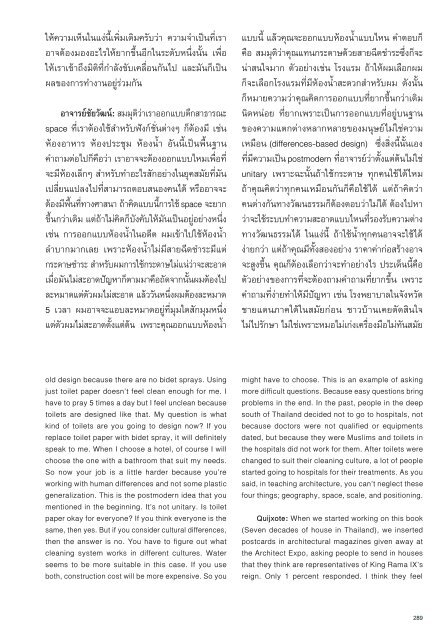บ้านเรือนถิ่นไทยในช่วงเจ็ดทศวรรษ 2489-2559
Create successful ePaper yourself
Turn your PDF publications into a flip-book with our unique Google optimized e-Paper software.
ให้ความเห็นในแง่นี้เพิ่มเติมครับว่า ความจำเป็นที่เรา<br />
อาจต้องมองอะไรให้ยากขึ้นอีกในระดับหนึ่งนั้น เพื่อ<br />
ให้เราเข้าถึงมิติที่กำลังขับเคลื่อนกันไป และมันก็เป็น<br />
ผลของการทำงานอยู่ร่วมกัน<br />
อาจารย์ชัยวัฒน์: สมมุติว่าเราออกแบบตึกสาธารณะ<br />
space ที่เราต้องใช้สำหรับฟังก์ชั่นต่างๆ ก็ต้องมี เช่น<br />
ห้องอาหาร ห้องประชุม ห้องน้ำ อันนี้เป็นพื้นฐาน<br />
คำถามต่อไปก็คือว่า เราอาจจะต้องออกแบบไหมเพื่อที่<br />
จะมีห้องเล็กๆ สำหรับทำอะไรสักอย่างในยุคสมัยที่มัน<br />
เปลี่ยนแปลงไปที่สามารถตอบสนองคนได้ หรืออาจจะ<br />
ต้องมีพื้นที่ทางศาสนา ถ้าคิดแบบนี้การใช้ space จะยาก<br />
ขึ้นกว่าเดิม แต่ถ้าไม่คิดก็บังคับให้มันเป็นอยู่อย่างหนึ่ง<br />
เช่น การออกแบบห้องน้ำในอดีต ผมเข้าไปใช้ห้องน้ำ<br />
ลำบากมากเลย เพราะห้องน้ำไม่มีสายฉีดชำระมีแต่<br />
กระดาษชำระ สำหรับผมการใช้กระดาษไม่แน่ว่าจะสะอาด<br />
เมื่อมันไม่สะอาดปัญหาก็ตามมาคือถัดจากนั้นผมต้องไป<br />
ละหมาดแต่ตัวผมไม่สะอาด แล้ววันหนึ่งผมต้องละหมาด<br />
5 เวลา ผมอาจจะแอบละหมาดอยู่ที่มุมใดสักมุมหนึ่ง<br />
แต่ตัวผมไม่สะอาดตั้งแต่ต้น เพราะคุณออกแบบห้องน้ำ<br />
แบบนี้ แล้วคุณจะออกแบบห้องน้ำแบบไหน คำตอบก็<br />
คือ สมมุติว่าคุณแทนกระดาษด้วยสายฉีดชำระซึ่งก็จะ<br />
น่าสนใจมาก ตัวอย่างเช่น โรงแรม ถ้าให้ผมเลือกผม<br />
ก็จะเลือกโรงแรมที่มีห้องน้ำสะดวกสำหรับผม ดังนั้น<br />
ก็หมายความว่าคุณคิดการออกแบบที่ยากขึ้นกว่าเดิม<br />
นิดหน่อย ที่ยากเพราะเป็นการออกแบบที่อยู่บนฐาน<br />
ของความแตกต่างหลากหลายของมนุษย์ไม่ใช่ความ<br />
เหมือน (differences-based design) ซึ่งสิ่งนี้นั้นเอง<br />
ที่มีความเป็น postmodern ที่อาจารย์ว่าตั้งแต่ต้นไม่ใช่<br />
unitary เพราะฉะนั้นถ้าใช้กระดาษ ทุกคนใช้ได้ไหม<br />
ถ้าคุณคิดว่าทุกคนเหมือนกันก็คือใช้ได้ แต่ถ้าคิดว่า<br />
คนต่างกันทางวัฒนธรรมก็ต้องตอบว่าไม่ได้ ต้องไปหา<br />
ว่าจะใช้ระบบทำความสะอาดแบบไหนที่รองรับความต่าง<br />
ทางวัฒนธรรมได้ ในแง่นี้ ถ้าใช้น้ำทุกคนอาจจะใช้ได้<br />
ง่ายกว่า แต่ถ้าคุณมีทั้งสองอย่าง ราคาค่าก่อสร้างอาจ<br />
จะสูงขึ้น คุณก็ต้องเลือกว่าจะทำอย่างไร ประเด็นนี้คือ<br />
ตัวอย่างของการที่จะต้องถามคำถามที่ยากขึ้น เพราะ<br />
คำถามที่ง่ายทำให้มีปัญหา เช่น โรงพยาบาลในจังหวัด<br />
ชายแดนภาคใต้ในสมัยก่อน ชาวบ้านเคยตัดสินใจ<br />
ไม่ไปรักษา ไม่ใช่เพราะหมอไม่เก่งเครื่องมือไม่ทันสมัย<br />
old design because there are no bidet sprays. Using<br />
just toilet paper doesn’t feel clean enough for me. I<br />
have to pray 5 times a day but I feel unclean because<br />
toilets are designed like that. My question is what<br />
kind of toilets are you going to design now? If you<br />
replace toilet paper with bidet spray, it will definitely<br />
speak to me. When I choose a hotel, of course I will<br />
choose the one with a bathroom that suit my needs.<br />
So now your job is a little harder because you’re<br />
working with human differences and not some plastic<br />
generalization. This is the postmodern idea that you<br />
mentioned in the beginning. It’s not unitary. Is toilet<br />
paper okay for everyone? If you think everyone is the<br />
same, then yes. But if you consider cultural differences,<br />
then the answer is no. You have to figure out what<br />
cleaning system works in different cultures. Water<br />
seems to be more suitable in this case. If you use<br />
both, construction cost will be more expensive. So you<br />
might have to choose. This is an example of asking<br />
more difficult questions. Because easy questions bring<br />
problems in the end. In the past, people in the deep<br />
south of Thailand decided not to go to hospitals, not<br />
because doctors were not qualified or equipments<br />
dated, but because they were Muslims and toilets in<br />
the hospitals did not work for them. After toilets were<br />
changed to suit their cleaning culture, a lot of people<br />
started going to hospitals for their treatments. As you<br />
said, in teaching architecture, you can’t neglect these<br />
four things; geography, space, scale, and positioning.<br />
Quijxote: When we started working on this book<br />
(Seven decades of house in Thailand), we inserted<br />
postcards in architectural magazines given away at<br />
the Architect Expo, asking people to send in houses<br />
that they think are representatives of King Rama IX’s<br />
reign. Only 1 percent responded. I think they feel<br />
289


















